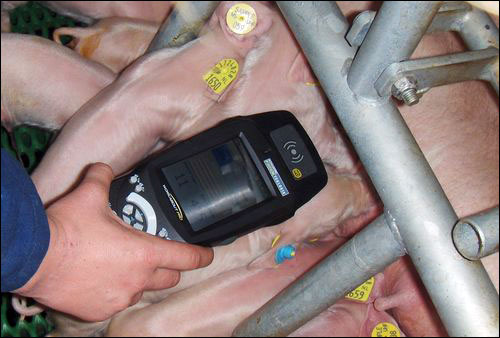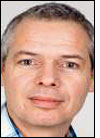Sep 26, 2012Schippers, a Dutch livestock farm tools and technology provider, has completed a three-year pilot of ultrahigh-frequency (UHF) RFID tags for pigs. The company developed the pilot with PureSpekt, and plans to begin marketing the tags in November 2012. The UHF tags, designed specifically to fit within a piglet's ear and track the animal from birth to slaughter, promise to be a less expensive solution than the low-frequency (LF) tags more commonly used in the swine industry, and to have a longer read range, thereby enabling the tags to be read from several meters away using both fixed and handheld readers.
Schippers sells products around the world to farmers of livestock—including pigs, poultry and cattle—such as fertility support, hygiene products, pest control and animal identification. Approximately four years ago, the company began investigating UHF RFID solutions for tracking animals, particularly pigs. "We were convinced that there are challenges coming in the business that will make it very important to identify every piglet," says Peter Beljaars, Schippers' product manager for animal identification. Those challenges include pending European Union and Dutch regulations requiring that consumers be provided with information regarding the quality and supply chain of the meat they purchase, as well as higher expectations from consumers related to meat quality, and the need for farms to improve their own management in order to compensate for increasingly thin profit margins.

Most RFID tags currently in use by pig farmers are low-frequency, but there are shortcomings related to LF RFID technology—namely, the high tag cost, as well as the need for a reader to be placed within several centimeters of a tag in order to be able to read it. "So we started thinking about UHF," Beljaars says. The firm began working with passive EPC Gen 2 tag manufacturer PureSpekt to develop a UHF tag of a very similar form factor to the existing LF ear tags, and launched a pilot involving farms throughout Holland, as well as in Switzerland, Austria and Germany. The pigs were fitted with the ear tags designed by PureSpekt and Schippers, after which Schippers tested readers with those tags and worked with software to manage the collected read data. Information was tracked when the animals were first fitted with the tags, when vaccinations and other services where provided, and when the pigs were transported from the farm. The pilot also involves a Dutch slaughterhouse where readers are being used to capture tag ID numbers, including a final read after the animals are slaughtered.
The tags were created in two processes. First, a plastic, cup-shaped disk was molded to a pin inserted through the animal's ear. A custom-made PureSpekt RFID inlay (containing an Impinj Monza 4 chip) was then placed inside the cup, and a second process molded the inlay into the cup. The tag was designed to meet the temperature and pressure used during the molding process, and to continue operating under those conditions. The tag itself measures 28.4 millimeters (1.12 inches) in diameter, while the inlay inside it measures 25 millimeters (1 inch) in diameter.
At the farms, Schippers installed an Impinj Speedway Revolution R420 reader with four antennas, attached to the ceiling above the piglets, as well as one on two walls. Each piglet was fitted with the UHF RFID tag. A Psion Workabout Pro G2/G3 handheld interrogator was used to capture each tag's unique ID number, and to link to data input about the animal, such as its birth date, weight, location and parents' ID. All of this information is then stored in PigExpert software provided by Dutch software company Agrisyst. The software, commonly used by farmers, was designed for LF technology, but was modified for the pilot to manage data from the UHF tags. Each time a tag was read, that data was forwarded to the PigExpert software, thereby creating an "electronic passport" for that particular pig, including all details pertaining to its health on the farm.
At the slaughterhouse, Schippers' researchers read each animal's tag as it arrives, and again after slaughter. The interrogators capture the ID numbers and transmit that data to a computer loaded with the PigExpert software, which, at this time, is not integrated with the slaughterhouse's own management system. In the future, the company reports, that information will be shared with the slaughterhouse. Currently, after the pig carcass is hung on a hook (attached to a conveyor) that stays with the carcass as it is processed, the slaughterhouse's staff views the meat's quality and weight, and reads an LF RFID tag attached to that hook, as well as entering data into the slaughterhouse's system to be linked to the hook's ID number. That process creates a record of the pig's health and size as the animal is then butchered and processed for retail sale of the meat. In the future, Beljaars says, a UHF tag will be attached to the hook. That hook tag will then be automatically linked in the software to the ID tag on the pig's ear.
To date, the pilot has led Schippers to make several modifications to the technology, according to Beljaars. He says he found that when a pig was tagged very shortly after birth, its ear grew so much prior to slaughter that the tag tended to drop through the piecing and out of the ear. The company then developed a tag with a narrower pin that creates a smaller hole in the ear; this tag, he says, is proving to stay in the pig's ear throughout its life, even as the animal grows. The tag's read range is still shorter than Beljaars would like—he hopes for a range of at least 3 meters (9.8 feet)—but thus far, he says, it has proven to be slightly less. Compared with LF, UHF signals are more sensitive to obstructions created by water or objects containing water (such as people and swine). However, tag redevelopment and antenna placement have eliminated that problem, Beljaars reports.
Schippers will be selling the UHF ear tags in November, along with handheld and fixed readers and Schippers' own stick antenna, while users could also acquire the UHF version of the PigExpert software.
Schippers will not be the first company, however, to market a UHF RFID solution designed for pigs. In December 2011, the Danish Agriculture & Food Council's Pig Research Center completed a three-year pilot that tested the use of EPC Gen 2 UHF RFID technology to track swine from farm to slaughterhouse. The project, known as PigTracker, included five Danish pig breeders, with up to 3,000 animals receiving EPC Gen 2 passive ear tags developed by TraceCompany (see PigTracker Project Finds UHF Tags Effective for Swine). Recently, TraceCompany began marketing the tags used for the PigTracker application. TraceCompany's ear tag, known as QuickTag Q1 UHF/B, is now commercially available, and is in use in about five herds, reports Niels Peter Baadsgaard, the Pig Research Center's chief researcher, who helped develop and test the technology. Like the Schippers solution, the TraceCompany ear tag is made with a Monza 4 chip.


